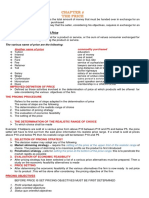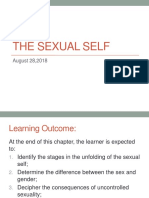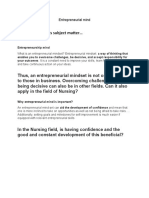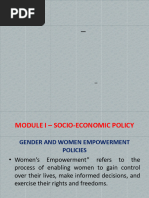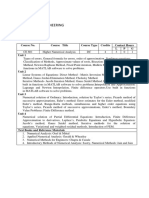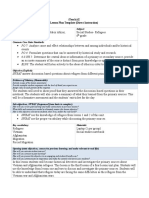0 ratings0% found this document useful (0 votes)
98 viewsWomen Empowerment
Women Empowerment
Uploaded by
Humera MisterThis document discusses women empowerment and the areas that need development for women, including social, educational, and economic development. It outlines key social legislation that has promoted women's rights and status in India since 1950. It also discusses the importance of educational development for women's awareness, literacy rates, and income generating skills. Promoting small family norms through family planning programs and empowering women are seen as important for population control and development.
Copyright:
© All Rights Reserved
Available Formats
Download as PPTX, PDF, TXT or read online from Scribd
Women Empowerment
Women Empowerment
Uploaded by
Humera Mister0 ratings0% found this document useful (0 votes)
98 views11 pagesThis document discusses women empowerment and the areas that need development for women, including social, educational, and economic development. It outlines key social legislation that has promoted women's rights and status in India since 1950. It also discusses the importance of educational development for women's awareness, literacy rates, and income generating skills. Promoting small family norms through family planning programs and empowering women are seen as important for population control and development.
Original Title
Women empowerment
Copyright
© © All Rights Reserved
Available Formats
PPTX, PDF, TXT or read online from Scribd
Share this document
Did you find this document useful?
Is this content inappropriate?
This document discusses women empowerment and the areas that need development for women, including social, educational, and economic development. It outlines key social legislation that has promoted women's rights and status in India since 1950. It also discusses the importance of educational development for women's awareness, literacy rates, and income generating skills. Promoting small family norms through family planning programs and empowering women are seen as important for population control and development.
Copyright:
© All Rights Reserved
Available Formats
Download as PPTX, PDF, TXT or read online from Scribd
Download as pptx, pdf, or txt
0 ratings0% found this document useful (0 votes)
98 views11 pagesWomen Empowerment
Women Empowerment
Uploaded by
Humera MisterThis document discusses women empowerment and the areas that need development for women, including social, educational, and economic development. It outlines key social legislation that has promoted women's rights and status in India since 1950. It also discusses the importance of educational development for women's awareness, literacy rates, and income generating skills. Promoting small family norms through family planning programs and empowering women are seen as important for population control and development.
Copyright:
© All Rights Reserved
Available Formats
Download as PPTX, PDF, TXT or read online from Scribd
Download as pptx, pdf, or txt
You are on page 1of 11
Women empowerment
MS. HUMERA MISTER
DEFINITION
Women empowerment is the process by which
women strengthens their capacity individually and
collectively to identify, understand and overcome
gender discrimination , thus taking control of their lives.
AREA DEVELOPS TO THE WOMEN
The women need to developed in some areas that
are :
Social development.
Educational development.
Economical development.
Implementing income generating schemes.
Promotion of small family norms.
SOCIAL DEVELOPMENT :-
Social development of women means raising the status of
women in society. Women in male dominating society that is
patriarchal from of society do not get the same status as men
especially in decision making.
Social legislation has brought a charge by developing the
women socially. Now a days , if women is compared with
the women earlier ages, they are having more privileges.
This is due to certain social legislation.
SOCIAL LEGISLATION
In1950, New constitution of India accorded equal right to women.
All women now enjoy equal political right with men. They have the
right to vote and have right to hold public office.
In 1955, Hindu marriage Act and Divorce Act has removed several
disabilities. No Hindu can marry second.
In 1978, the child marriage restraint amendment Act, has raised the
marriage of girls from 15 to 18 year, for boys 18 to 21years.
In 1976, the equal remuneration Act, 1976 provide for equal
payment of remuneration to man and women.
EDUCATIONAL DEVELOPMENT
Women need to be educationally developed. It has been
seen that women receive less formal education then man and
at the same time , women’s knowledge , ability and coping
mechanism often go unrecognized.
Education will help them in in creating awareness regarding
demerits and merits of large and small family size as well as
other aspect of health. The grant are provided by central
social welfare board to voluntary organization to conduct
courses of two or three year duration for having education . In
order to achieve increased literacy rate , there is need to
bring change in policies and programmes.
ECONOMICAL DEVELOPMENT Educational development and
social development will bring a change in economic condition
of the women. Women can be empowered by :-
IMPLEMENTING INCOME GENERATING SCHEMES :
Technical information is imparted and strategies to plan
action towards development and against injustice.
Vocational courses for women.
Opening of women polytechnics.
Rehabilitation of women – By providing vocational training
cum employment and residential care to old widows ,
deserted women.
In 2000 , the govt. of India adopted a national policy for
the empowerment of women. National Health Policy was
under consideration in 2005 for implementation and it to be
reviewed twice a year. The aim of the policy are :-
Women equality in power sharing and active participation
in decision making.
Comprehensive economic and social empowerment of
women.
The advancement, development and empowerment of
women in all spheres of life.
CONTI…….
Strengthening and formation of relevant institution
mechanisms.
Partnership with community based programme.
Implementation of international obligation and co-
operation at international, reginal and subregional levels.
More responsive judicial legal system that are sensitive
to women’s head.
PROMTION OF SMALL FAMILY NORMS
Population control can be achieved by promoting small family
norms. The small family norms in the objective of family
welfare programme. This to achieve control over country’s
population. The small family norms was promoted by the
slogans
“DO YA TEEN BUS ” In the year 1970 because of 3 child family
model. Welfare programme was to achieve and promote small
family norms :-
Family welfare programme.
Family planning method.
Mass communication.
Information, education and communication.
Registration of couples.
target couple to be directed towards family planning method.
Cafeteria approach for adoption of family planning methods
Involvement of health education institution for promotion of
small family.
Empowering women.
You might also like
- Classbook Rooftop 6Document4 pagesClassbook Rooftop 6SandraVega71% (7)
- Contemporary Social Issues Assignment 2Document10 pagesContemporary Social Issues Assignment 2Pippa McFallNo ratings yet
- Prelim TWCDDocument24 pagesPrelim TWCDMaye ArugayNo ratings yet
- The Effect of MicrofinanceDocument12 pagesThe Effect of MicrofinancePhoenix DadivitanNo ratings yet
- Kolb Learning Style InventoryDocument3 pagesKolb Learning Style Inventoryzayyadi_has100% (1)
- DLL-TPS Week 1Document6 pagesDLL-TPS Week 1rhyzene100% (2)
- Week 14 Non MaleficenceDocument13 pagesWeek 14 Non MaleficenceRoxanne Ivy ViolaNo ratings yet
- Sexual Harassment and ParaphiliasDocument4 pagesSexual Harassment and ParaphiliasGwen Mark CrespoNo ratings yet
- Full Notes Gss5 EthicsDocument13 pagesFull Notes Gss5 EthicsVincent Miguel BastieroNo ratings yet
- Chapter 5Document5 pagesChapter 5Aruray BorbonNo ratings yet
- 4 UtilitarianismDocument35 pages4 UtilitarianismAdrian RoxasNo ratings yet
- SOCIO 102-Lesson 5: The Process of ReproductionDocument33 pagesSOCIO 102-Lesson 5: The Process of ReproductionRessaNo ratings yet
- What Is Quantitative ResearchDocument3 pagesWhat Is Quantitative Researchjade risenNo ratings yet
- CHAPTER 1 - Dimensions of Ethics and Moral BehaviorDocument2 pagesCHAPTER 1 - Dimensions of Ethics and Moral BehaviortrishaNo ratings yet
- The Level of Empowerment of Overseas Filipino Women WorkersDocument82 pagesThe Level of Empowerment of Overseas Filipino Women WorkersEsttie RadamNo ratings yet
- Assign UndselfDocument1 pageAssign UndselfJia HuiNo ratings yet
- Gender DefinitionsDocument2 pagesGender DefinitionsShelley-Ann HartNo ratings yet
- CHAPTER 3 Market IntegrationDocument26 pagesCHAPTER 3 Market Integrationshiryl gabrielNo ratings yet
- Module 1 To 4 Reflection Paper On CWTS (1ST Sem)Document2 pagesModule 1 To 4 Reflection Paper On CWTS (1ST Sem)bmaria krizzaNo ratings yet
- Anti & Alter GlobalizationDocument11 pagesAnti & Alter GlobalizationJahedHossainNo ratings yet
- Week 7Document33 pagesWeek 7Jakmensar Dewantara Siagian0% (2)
- Final Thesis ManuscriptDocument104 pagesFinal Thesis ManuscriptŇel DanNo ratings yet
- The Global Manager's EnvironmentDocument6 pagesThe Global Manager's EnvironmentBogdan Alexandru DidaNo ratings yet
- 7 Dosa Mahatma GhandiDocument7 pages7 Dosa Mahatma GhandiAnand IcuBegNo ratings yet
- Theories of GovernanceDocument21 pagesTheories of GovernanceGashaw YematawNo ratings yet
- Concept of Globalization - Contemporary ArtsDocument22 pagesConcept of Globalization - Contemporary ArtsEdrickLouise DimayugaNo ratings yet
- Sociology As A ScienceDocument3 pagesSociology As A ScienceAmanda Liston LaroccaNo ratings yet
- Explain The Relationship Between Risk and ReturnDocument2 pagesExplain The Relationship Between Risk and ReturnKristine Claire PangandoyonNo ratings yet
- Marketing The Small Business: Reporters: Darlina Pangan Angelika Reyes Cassandra PeraltaDocument38 pagesMarketing The Small Business: Reporters: Darlina Pangan Angelika Reyes Cassandra PeraltajudyNo ratings yet
- Wealth InequalityDocument4 pagesWealth InequalityChun KedNo ratings yet
- Proclamation of The Philippine IndependenceDocument1 pageProclamation of The Philippine IndependenceDeeekayrNo ratings yet
- Minimum WagesDocument6 pagesMinimum Wagesapi-255462987No ratings yet
- First Chapter ProfessionalismDocument42 pagesFirst Chapter ProfessionalismMarina ManzoorNo ratings yet
- The Cultural Differences ArgumentDocument3 pagesThe Cultural Differences Argumentjasper buenaventuraNo ratings yet
- Presenters: Horace M. Estrella Jay Mart A. Lazana Princess Camille R. HipolitoDocument23 pagesPresenters: Horace M. Estrella Jay Mart A. Lazana Princess Camille R. HipolitoHorace EstrellaNo ratings yet
- Globalization: Positive or Negative: American Journey: Glencoe, 2005 Chapter 19, Section 2, Pgs 561-566Document6 pagesGlobalization: Positive or Negative: American Journey: Glencoe, 2005 Chapter 19, Section 2, Pgs 561-566Paulina quezadaNo ratings yet
- Lesson 4 Market GlobalismDocument10 pagesLesson 4 Market GlobalismLoiz Santos Trinidad100% (1)
- Sexual and Reproductive Health of Young People With Disability in Ethiopia A Study On Knowledge, Attitude and Practice A Cross-Sectional StudyDocument11 pagesSexual and Reproductive Health of Young People With Disability in Ethiopia A Study On Knowledge, Attitude and Practice A Cross-Sectional StudyKharohmah SNo ratings yet
- Review of LiteratureDocument22 pagesReview of LiteraturePriyanjali SainiNo ratings yet
- Social Enterprises - DoroteoDocument4 pagesSocial Enterprises - DoroteoJivNo ratings yet
- DE VERA - Teenage Pregnancy Preventive Programs in Tabaco City Philippines - Full ShortenedDocument11 pagesDE VERA - Teenage Pregnancy Preventive Programs in Tabaco City Philippines - Full ShortenedKevin de VeraNo ratings yet
- Chapter 11 - Physical and Cognitive Development in AdolescenceDocument11 pagesChapter 11 - Physical and Cognitive Development in AdolescenceColeen AlcontinNo ratings yet
- "A Study On Assessment of Entrepreneurial Skills Among Students" PDFDocument12 pages"A Study On Assessment of Entrepreneurial Skills Among Students" PDFharshithaNo ratings yet
- What Is LeadershipDocument21 pagesWhat Is LeadershiptaapNo ratings yet
- Module 3. Education of The Youth in The NSTPDocument3 pagesModule 3. Education of The Youth in The NSTPConnie Frances Mangubat100% (1)
- Activity 6 (Chapter 3-Reflective Essay) Dated January 29, 2021Document2 pagesActivity 6 (Chapter 3-Reflective Essay) Dated January 29, 2021Kylene Edelle LeonardoNo ratings yet
- W3 - W4 The Global Economy - Module PDFDocument4 pagesW3 - W4 The Global Economy - Module PDFJeariel TolentinoNo ratings yet
- A Quick Look at This Subject Ma2er : Entrepreneurial MindDocument4 pagesA Quick Look at This Subject Ma2er : Entrepreneurial MindKianne Rae Fernandez PalmaNo ratings yet
- Chapter One Research MethodsDocument36 pagesChapter One Research MethodsBuze Tf100% (1)
- Which Global Issue Do We Need To Prioritize First and Set Upon As A Global CitizenDocument1 pageWhich Global Issue Do We Need To Prioritize First and Set Upon As A Global CitizenGALVEZ, JOHN LEENARD T.No ratings yet
- Gender AND Society: Jerrylyn Alegre Btvted-2C GFDDocument12 pagesGender AND Society: Jerrylyn Alegre Btvted-2C GFDJerrylyn AlegreNo ratings yet
- Globalization's Effect On Health Care Case StudyDocument2 pagesGlobalization's Effect On Health Care Case StudySherah Danielle de Vera100% (1)
- Social InnovationDocument7 pagesSocial InnovationAmit PathakNo ratings yet
- Ethics in Healthcare PowerpointDocument10 pagesEthics in Healthcare PowerpointEnrique SaludesNo ratings yet
- Essay Project 2Document6 pagesEssay Project 2api-535694195No ratings yet
- Debate Points Government WhipDocument6 pagesDebate Points Government WhipIzzah FarishaNo ratings yet
- The Effects of Globalization On CultureDocument5 pagesThe Effects of Globalization On CultureLorelyn CorageNo ratings yet
- Child Adoption As A Panacea For Childlessness in The Face of Ethical Issues Arising From Assisted Reproductive TechnologiesDocument12 pagesChild Adoption As A Panacea For Childlessness in The Face of Ethical Issues Arising From Assisted Reproductive TechnologiesOlusolaNo ratings yet
- The Family As The Basic Unit of SocietyDocument6 pagesThe Family As The Basic Unit of SocietyYza Belle RamoNo ratings yet
- Concepts of DemographyDocument5 pagesConcepts of DemographyBapu FinuNo ratings yet
- Chapter 3 - The Basic Elements of Supply and DemandDocument19 pagesChapter 3 - The Basic Elements of Supply and DemandSaji JimenoNo ratings yet
- Marketing, Advertising and Product Safety-Ethical IssuesDocument51 pagesMarketing, Advertising and Product Safety-Ethical IssuesKochappen Ipe Kumar100% (5)
- Module I FybmsDocument26 pagesModule I Fybmsplayerjod2No ratings yet
- Commercial Sex WorkersDocument7 pagesCommercial Sex WorkersHumera MisterNo ratings yet
- Utilize Community Resources For Self and FamilyDocument38 pagesUtilize Community Resources For Self and FamilyHumera Mister100% (2)
- Substance AbuseDocument24 pagesSubstance AbuseHumera MisterNo ratings yet
- Growth and DevelopmentDocument32 pagesGrowth and DevelopmentHumera MisterNo ratings yet
- Elderly AbuseDocument23 pagesElderly AbuseHumera MisterNo ratings yet
- 24-8 HumeraDocument201 pages24-8 HumeraHumera MisterNo ratings yet
- 2024 2025 Academic CalendarDocument1 page2024 2025 Academic CalendarAliou Diallo100% (1)
- Rizal Final RequirementDocument7 pagesRizal Final RequirementMelissa Kayla ManiulitNo ratings yet
- AIESEC Mobility ProgramvDocument16 pagesAIESEC Mobility ProgramvAditya AjitNo ratings yet
- Notification PPSC Sister Tutor PostsDocument2 pagesNotification PPSC Sister Tutor PostsAbhishek7027No ratings yet
- Contact Linguistics Final ExamDocument20 pagesContact Linguistics Final Exammilena pNo ratings yet
- Computerization of Existing Grading System of San Isidro Elementary SchoolDocument8 pagesComputerization of Existing Grading System of San Isidro Elementary Schoolzephyr7231372650% (4)
- Branksome Bugle: Save Our Swimming PoolDocument8 pagesBranksome Bugle: Save Our Swimming PoolLiam PapeNo ratings yet
- Edsu 533 Signature Assignment RubricDocument3 pagesEdsu 533 Signature Assignment Rubricapi-239062048No ratings yet
- Brooke Bennett Resume 2Document2 pagesBrooke Bennett Resume 2api-299335442No ratings yet
- Analytical Exposition TextDocument3 pagesAnalytical Exposition Textannisa100% (1)
- CURRICULUM VITAE NSABIYUMVA Radjab - 20170705 PDFDocument14 pagesCURRICULUM VITAE NSABIYUMVA Radjab - 20170705 PDFRadjab NsabiyumvaNo ratings yet
- MtechCivil EnggSyllabud PDFDocument15 pagesMtechCivil EnggSyllabud PDFSyed Javed ArifNo ratings yet
- Construction of School Perimeter FenceDocument2 pagesConstruction of School Perimeter Fencejovito limot0% (1)
- Development of Phonological Processes in TypicallyDocument7 pagesDevelopment of Phonological Processes in TypicallyAlexander DeckerNo ratings yet
- Values EducationDocument96 pagesValues EducationRicky ProctanNo ratings yet
- 5 Comprehensive Organ't Change ApproachesDocument28 pages5 Comprehensive Organ't Change Approachesxmyth88100% (2)
- How To Write Comments On Performance AppraisalDocument6 pagesHow To Write Comments On Performance AppraisalRay VictorNo ratings yet
- Supervisory ManagementDocument203 pagesSupervisory ManagementanakngtetengNo ratings yet
- Course Description 100Document11 pagesCourse Description 100krissy100% (1)
- What To Write in Dissertation AcknowledgementsDocument7 pagesWhat To Write in Dissertation AcknowledgementsINeedSomeoneToWriteMyPaperOlathe100% (2)
- Takaki Journey Box Lesson PlanDocument6 pagesTakaki Journey Box Lesson Planapi-267854883No ratings yet
- Manuale de Limba Engleza Aprobate de Ministerul Educatiei Si Cercetarii Distribuite de Fischer InternationalDocument2 pagesManuale de Limba Engleza Aprobate de Ministerul Educatiei Si Cercetarii Distribuite de Fischer InternationalAngiNo ratings yet
- Resume 2020 For Dps 5Document2 pagesResume 2020 For Dps 5api-511532936No ratings yet
- Pmi Acp23 PDFDocument82 pagesPmi Acp23 PDFNancy Rah100% (3)
- Namma Clinic Final Selection ListDocument36 pagesNamma Clinic Final Selection Listsunilchandu95No ratings yet
- 1Document121 pages1Alvin RodolfoNo ratings yet
- Abbey Group Aims High (18 Stories, Community Center) at 1282 BoylstonDocument8 pagesAbbey Group Aims High (18 Stories, Community Center) at 1282 BoylstonfenwaynewsNo ratings yet









